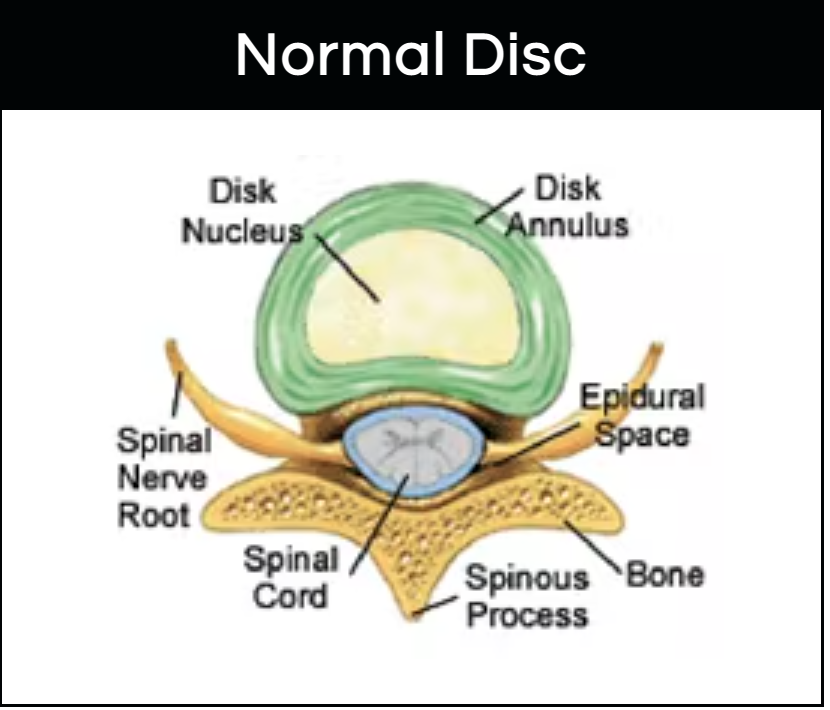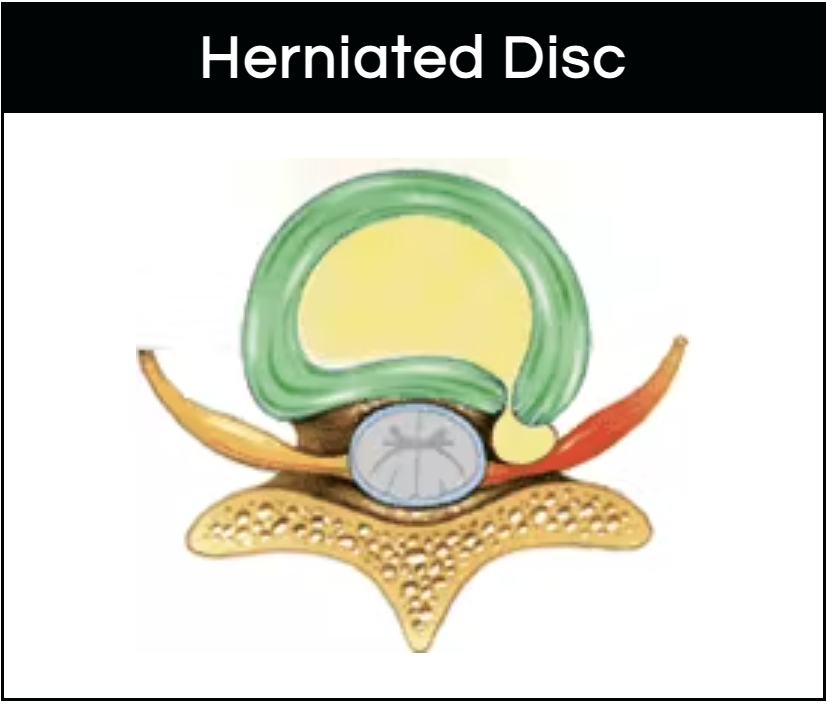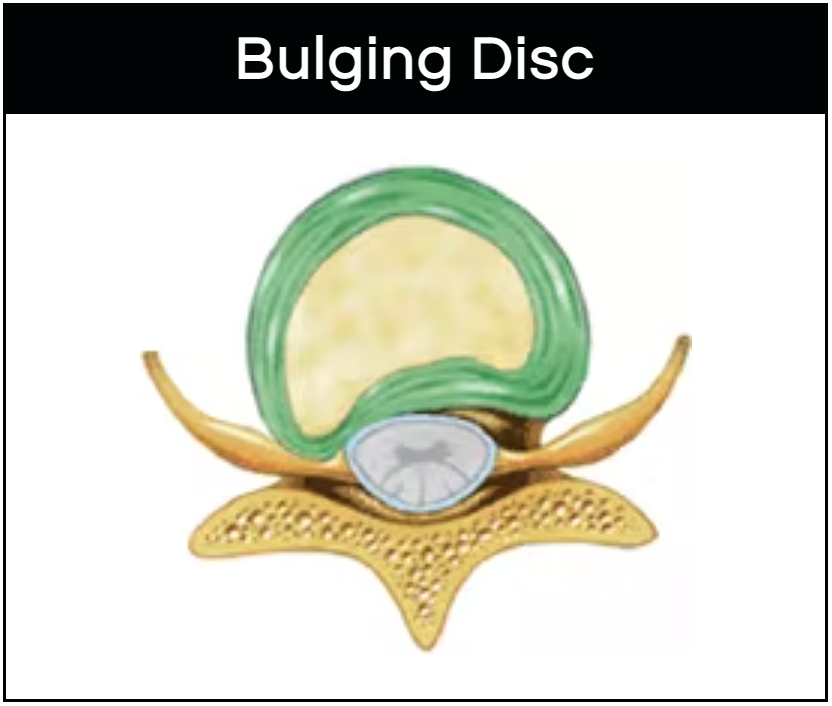Herniated / Bulging Disc
The goal of these treatments and lifestyle changes is to improve spinal alignment and reduce inflammation without surgery. Surgery should be the last resort and should only be considered if all conservative treatments fail.
The human vertebral (spinal) column is made up of 26 stacked bones comprised of 33 vertebrae, which are distributed into 5 regions:
- 7 cervical vertebrae (neck bones in the cervical spine)
- 12 thoracic vertebrae (upper back bones in the thoracic spine)
- 5 lumbar vertebrae (lower back bones in the lumbar spine)
- 5 fused sacral vertebrae (triangular bone wedged between the hip bones in the sacrum)
- 4 variably fused coccygeal vertebrae (at the base of the spine in the coccyx-tailbone)
Physical Therapy for Bulging and Herniated Discs
Normal Disc
The spinal column has a series of curvatures and the bones get larger and more stable the further you go down because the lower vertebrae carry more weight than the upper ones. The 33 vertebrae are separated from one another, cushioned and protected by shock-absorbing intervertebral discs (intervertebral fibrocartilage). Ligaments and facet joints connect the individual vertebrae to allow movement and maintain the spine’s normal alignment and curvature.
The spinal channel in the center of the spinal column contains spinal fluid, which surrounds the spinal cord and spinal nerves. The strong spinal column protects the spinal cord and nerves. Nerves enter and exit the spinal canal through small openings on each side of the spine between the vertebrae, called foramina.

Herniated Discs and Bulging Discs – Common Causes of Back Pain
Millions of Americans are adversely impacted by back pain each year. Two of the most common causes of back and neck pain are herniated and bulging discs. According to Corporate Wellness Magazine, the total cost to employers for back pain amounts to $34,600 per 100 employees annually. Among the high ticket items are workers’ compensation claims for herniated and bulging disc. If left untreated, these injuries could potentially cause irreversible nerve damage and cost thousands upward to hundreds of thousands of dollars to treat. Not to mention the downtime and time away from work needed to recover. That’s why it’s so important to quickly find out the cause of your neck or back pain and get it treated as soon as possible.
Herniated Disc vs Bulging Disc
People typically use the terms herniated disc and bulging disc interchangeably. But, they are two different conditions. Herniated Nucleus Pulposus (HNP) is the medical term for a herniated disc / ruptured disc / slipped disc (all the same thing). A herniated disc is one where the outer perimeter of the disc (annulus) is cracked or torn and part or all of the soft gelatinous part of the center core (nucleus pulposus) ruptures out. Usually, only a small part of the disc is affected. Herniated discs progress from prolapsed to protruding to extruding and to the final stage of sequestration where the disc material is severed from the main disc structure. The herniated disc itself does not hurt. The pain comes from nerve inflammation caused by discs that herniate near a nerve and compresses it and people with herniated discs are more likely to experience pain than those with bulging discs.

Bulging Disc
A bulging disc is different than a herniated disc in the respect that the outer wall is weakened, causing it to bulge outward, but not ruptured. Bulging discs are more common than herniated discs and are usually considered a normal part of aging. A bulging disc affects a much larger part of the disc than a herniated disc but only the outer layer of cartilage is involved. Sometimes the entire disc may bulge, but it’s usually a quarter to a half of its circumference that’s impacted. Although a bulging disc is not a herniated disc, it can become one if the weakened outer wall ruptures due to a sudden injury or great pressure on that disc.

Common Causes of Herniated Discs
Herniated discs are usually caused by degenerative disc changes or an injury but can also be caused by such things as:
- A pre-existing weakness in the annulus,
- A sudden increase in pressure through the disc causing the annulus to tear or crack, or
- A genetic predisposition to disc herniation.
Common Causes of Bulging Discs
The most common cause of bulging discs is degenerative dis disease (DDD), but can also be caused by:
- Sudden unexpected load to the intervertebral discs (e.g., motor vehicle accident or fall)
- Unexpected load or torsion of a disc due to improper or heavy lifting
- Repeated microtrauma over an extended period due to poor posture
- Genetics, smoking and obesity can also be contributory factors
Symptoms of Disc Herniation
People with herniated discs may experience some or all of these symptoms in the extremities and spine:
- Chronic pain at the compressed nerve
- Radicular (nerve root) pain and numbness along the compressed nerve pathway, usually only on one side of the body
- Pain that worsens at night
- Pain that worsens after standing or sitting
- Pain when walking short distance
- Numbness, aching, burning or tingling in the affected area
- Unexplained muscle weakness
- Loss of fine motor skills (cervical) / difficulty walking (lower spinal cord compression)
Symptoms of Bulging Discs
People with bulging discs may or may not be symptomatic. Those who are symptomatic may experience:
- Pain in the back or extremities
- Pins and needles sensation, burning, tingling or numbness in one or more extremities
- Muscle spasms, weakness or overactive reflexes
- Stiff neck, or back
Diagnosing Bulging and Herniated Discs
While these are two different conditions, similar methods are used to diagnose them including:
Spinal X-ray – as the name implies is an image of your spine that passes through the soft tissues onto camera film-like plates. Modern X-rays are usually digital. X-rays help doctors diagnose such conditions as:
- Arthritis
- Broken Bones / Fractures
- Spondylolisthesis
- Tumors
- Disc Degeneration
- Scoliosis or Kyphosis
- Congenital Abnormalities
Computed Tomography Scan (CAT / CT Scan) – painless, quick, accurate and noninvasive 3D images of the spine to rule out spinal column damage.
Magnetic Resonance Imaging (MRI) Scan – detailed images of a spine and surrounding tissues generated by a magnetic field, radio waves and a computer to diagnose certain diseases.
Discogram – mildly invasive X-ray diagnostic test that examines the intervertebral discs to determine if there is a ruptured disc or one with tears. It also helps determine if surgery is needed.
Treating Bulging and Herniated Discs
Nonsurgical treatments for both bulging and herniated discs may include:
- Physical Therapy
- Chiropractic treatments
- Acupuncture
- Heat / Ice Treatments
- Epidural Steroid Injections
- Nonsteroidal Anti-inflammatory Drugs (NSAIDs) / Muscle Relaxers / Nerve Pain Medications (e.g., Gabapentin)
Your doctor may also suggest lifestyle changes like quitting smoking, exercises to strengthen the muscles in the back, legs and abdomen and weight loss. The goal of these treatments and lifestyle changes is to improve spinal alignment and reduce inflammation without surgery. Surgery should be the last resort and should only be considered if all conservative treatments fail.